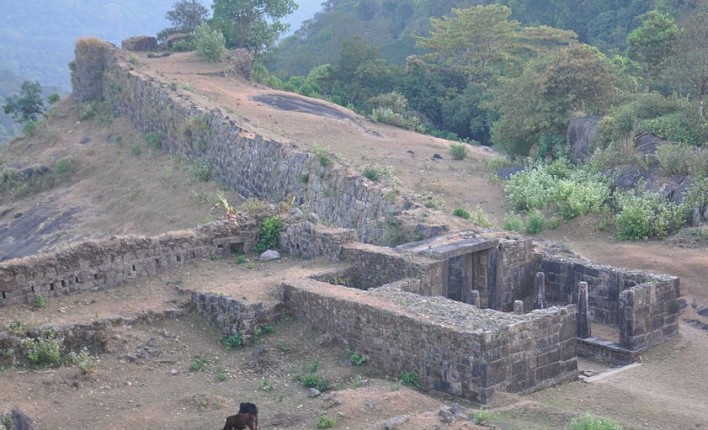The ideal epithet to describe the Kavaledurga fort is as a slice of forgotten history amidst the Western Ghats. It is one of the lesser visited historical monuments in the state, though in recent years archaeologists have been trying to restore some of the ancient structures within the remaining fortifications.
Kavaledurga Fort – the marvellous architecture
The Kavaledurga fort was originally built in the 9th century AD. The fort is a marvellous structure that includes complex defences and arrangements for rain water harvesting.
The fort walls built of granite blocks range from 30 to 40 ft in height. There are watch towers is strategic places. The entire fort is around 8 km in circumference with two types of defences. The village itself had two lines of fortification, while the fort had five lines of fortifications, following the natural contour of the hillocks. The original structure had guard houses flanking each gateway.

Excavations and findings
The remains of the palace have been unearthed from the ground, and it is possible to view the Durbar Hall, the swimming pools, the ammunition house, the jail, the horse and elephant stables, and even a Ghalige Battalu (a copper pot used to measure time). Recent excavations have unearthed a spacious veranda, a kitchen with a five-burner stone stove, a pooja room, and a bathroom with water supply system.
Read: Nagara Fort Or Bidanur Fort In Shivamogga – History Lover’s Paradise
Mesmerizing water channels
Another important and amazing aspect of the fort is the presence of the water channels. Some of these gather the natural flowing mountain waters to the various lakes dotted in and around the fort. Apparently the fort has water throughout the year, even during summer as a result of these water channels.
As one explores the fort, a structure that captures interest is a cave with a small pool near it. The cave holds year-round fresh water source called the Gadaa Theertha. Legend says that the mace (gadaa) of Bheema (one of the five Pandavas, from Mahabharatha) was used to dig out this water source. Many legendary sources mention this fort as providing shelter to the Pandavas, and the sages Agastya and Valmiki at various times.
Kavaledurga Fort an abode of Gods
There were around fifteen temples within the fortifications, but only three of the temples still exist – Kashi Vishwanatha temple, Sri Lakshmi Narayana temple and Shikareshwara temple. The Lakshmi Narayana temple is situated on a rock with natural steps leading up to it.The Shikareshwara temple is situated almost at the centre of the fort, on a natural hillock and affords a panoramic view of the area. The Kashi Vishwanatha temple is unique for its Islamic style doorway and the presence of two stone pillars at the entrance.
A brief history of the Kavaledurga fort
Though the original fort was built in the 9th century, it was later renovated and extended in the 14th century by a Belagutti king, Cheluvarangappa. In the 16th century, Hiriya Venkatappa Nayaka, the Keladi ruler added seven battlements to protect the fort. He renamed the fort as Bhuvanagiri fort.
At one point, the fort was called Kauledurga after the Kauli village situated near it. The fort was captured by Hyder Ali in the 18th century, and he left his soldiers called Kavalu Gaararu to guard the fort. The current name of the Kaveledurga fort is supposedly derived from this native term. From Hyder Ali, Tipu Sultan inherited the fort.
Kavaledurga was a taluq headquarters until 1882. Later the headquarters was moved to Thirthahalli.
How to reach Kavaledurga fort?
The Kavaledurga fort, sometimes called the Bhuvanagiri fort, is situated in Shimoga district. Travellers from Bengaluru will have to board the train/bus or drive down to Shimoga and from there to Thirthahalli.
From Thrithahalli, it is a further 16 km to the nearest village, Kavaledurga, near the fort. Villagers will be able to guide tourists to the trail that leads towards the Kavaledurga fort. The fort itself is accessible only by foot.
The fort is the ideal picnic spot for trekking enthusiasts. There are not many restaurants/hotels near the fort, so it is advisable to take your own food and water.
Also See: